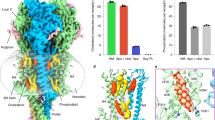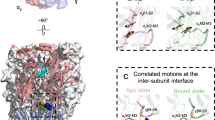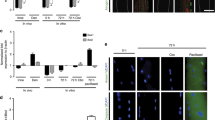Abstract
Distinct classes of acetylcholine receptor channels are formed when Xenopus oocytes are injected with combinations of the bovine α-, β-, γ- and δ- or the α-, β-, γ- and ε-subunit-specific messenger RNAs. The conductance and gating properties of the two classes of channels, in conjunction with the developmental changes in the muscular contents of the mRNAs, suggest that replacement of the γ-subunit by the ε-subunit is responsible for the functional alteration of the receptor during muscle development.
This is a preview of subscription content, access via your institution
Access options
Subscribe to this journal
Receive 51 print issues and online access
$199.00 per year
only $3.90 per issue
Buy this article
- Purchase on Springer Link
- Instant access to full article PDF
Prices may be subject to local taxes which are calculated during checkout
Similar content being viewed by others
References
Katz, B. & Miledi, R. J. Physiol., Lond. 224, 665–699 (1972).
Neher, E. & Sakmann, B. J. Physiol., Lond. 258, 705–729 (1976).
Sakmann, B., Bormann, J. & Hamill, O. P. Cold Spring Harb. Symp. quant. Biol. 48, 247–257 (1983).
Sakmann, B. & Brenner, H. R. Nature 276, 401–402 (1978).
Michler, A. & Sakmann, B. Devl Biol. 80, 1–17 (1980).
Fischbach, G. D. & Schuetze, S. M. J. Physiol., Lond. 303, 125–137 (1980).
Vicini, S. & Schuetze, S. M. J. Neurosci. 5, 2212–2224 (1985).
Fambrough, D. M. Physiol. Rev. 59, 165–227 (1979).
Karlin, A. in Cell Surface Reviews Vol. 6 (eds Cotman, C. W., Poste, G. & Nicolson, G. L.) 191–260 (North-Holland, Amsterdam, 1980).
Changeux, J.-P. Harvey Lect. 75, 85–254 (1981).
Conti-Tronconi, B. M. & Raftery, M. A. A. Rev. Biochem. 51, 491–530 (1982).
Noda, M. et al. Nature 299, 793–797 (1982).
Noda, M. et al. Nature 301, 251–255 (1983).
Noda, M. et al. Nature 302, 528–532 (1983).
Claudio, T., Ballivet, M., Patrick, J. & Heinemann, S. Proc. natn. Acad. Sci. U.S.A. 80, 1111–1115 (1983).
Sumikawa, K. et al. Nucleic Acids Res. 10, 5809–5822 (1982).
Devillers-Thiery, A., Giraudat, J., Bentaboulet, M. & Changeux, J.-P. Proc. natn. Acad. Sci. U.S.A. 80, 2067–2071 (1983).
Noda, M. et al. Nature 305, 818–823 (1983).
Tanabe, T. et al. Eur. J. Biochem. 144, 11–17 (1984).
Takai, T. et al. Eur. J. Biochem. 143, 109–115 (1984).
Kubo, T. et al. Eur. J. Biochem. 149, 5–13 (1985).
Shibahara, S. et al. Eur. J. Biochem. 146, 15–22 (1985).
LaPolla, R. J., Mayne, K. M. & Davidson, N. Proc. natn. Acad. Sci. U.S.A. 81, 7970–7974 (1984).
Boulter, J. et al. J. Neurosci. 5, 2545–2552 (1985).
Takai, T. et al. Nature 315, 761–764 (1985).
Mishina, M. et al. Nature 307, 604–608 (1984).
Mishina, M. et al. Nature 313, 364–369 (1985).
Sakmann, B. et al. Nature 318, 538–543 (1985).
Sakmann, B., Patlak, J. & Neher, E. Nature 286, 71–73 (1980).
Hamill, O. P. & Sakmann, B. Nature 294, 462–464 (1981).
Anderson, C. R. & Stevens, C. F. J. Physiol., Lond. 235, 655–691 (1973).
Colquhoun, D., Large, W. A. & Rang, H. P. J. Physiol., Lond. 266, 361–395 (1977).
Nathanson, N. M. & Hall, Z. W. Biochemistry 18, 3392–3401 (1979).
Brenner, H. R. & Sakmann, B. J. Physiol., Lond. 337, 159–171 (1983).
Schuetze, S. M. & Vicini, S. J. Neurosci. 4, 2297–2302 (1984).
Methfessel, C. et al. Pflügers Arch. ges. Physiol. (submitted).
Fenwick, E., Marty, A. & Neher, E. J. Physiol., Lond. 331, 577–597 (1982).
Colquhoun, D. & Sigworth, F. J. in Single Channel Recording (eds Sakmann, B. & Neher, E.) 191–263 (Plenum, New York, 1983).
Robinson, R. A. & Stokes, R. H. in Electrolyte Solution 2nd edn, 481–492 (Butterworth, London, 1959).
Hamill, O. P., Marty, A., Neher, E., Sakmann, B. & Sigworth, F. J. Pflügers Arch. ges. Physiol. 391, 85–100 (1981).
Sisson, S. & Grossman, J. D. in The Anatomy of the Domestic Animals 4th edn, 281–282 (Saunders, Philadelphia, 1964).
Karnovsky, M. J. J. Cell Biol. 23, 217–232 (1964).
Arthur, G. H. in Wright's Veterinary Obstetrics 3rd edn, 64–69 (Bailliere, Tindall & Cox, London, 1964).
Chirgwin, J. M., Przybyla, A. E., MacDonald, R. J. & Rutter, W. J. Biochemistry 18, 5294–5299 (1979).
McMaster, G. K. & Carmichael, G. G., Proc. natn. Acad. Sci. U.S.A. 74, 4835–4838 (1977).
Thomas, P. S. Proc. natn. Acad. Sci. U.S.A. 77, 5201–5205 (1980).
Weinstock, R., Sweet, R., Weiss, M., Cedar, H. & Axel, R. Proc. natn. Acad. Sci. U.S.A. 75, 1299–1303 (1978).
Author information
Authors and Affiliations
Rights and permissions
About this article
Cite this article
Mishina, M., Takai, T., Imoto, K. et al. Molecular distinction between fetal and adult forms of muscle acetylcholine receptor. Nature 321, 406–411 (1986). https://doi.org/10.1038/321406a0
Received:
Accepted:
Issue Date:
DOI: https://doi.org/10.1038/321406a0
This article is cited by
-
Recombinant cellular model system for human muscle-type nicotinic acetylcholine receptor α12β1δε
Cell Stress and Chaperones (2023)
-
Decoding the transcriptome of Duchenne muscular dystrophy to the single nuclei level reveals clinical-genetic correlations
Cell Death & Disease (2023)
-
Neuromuscular junction pathology is correlated with differential motor unit vulnerability in spinal and bulbar muscular atrophy
Acta Neuropathologica Communications (2022)
-
Lithium causes differential effects on postsynaptic stability in normal and denervated neuromuscular synapses
Scientific Reports (2021)
-
Truncating CHRNG mutations associated with interfamilial variability of the severity of the Escobar variant of multiple pterygium syndrome
BMC Genetics (2016)
Comments
By submitting a comment you agree to abide by our Terms and Community Guidelines. If you find something abusive or that does not comply with our terms or guidelines please flag it as inappropriate.



